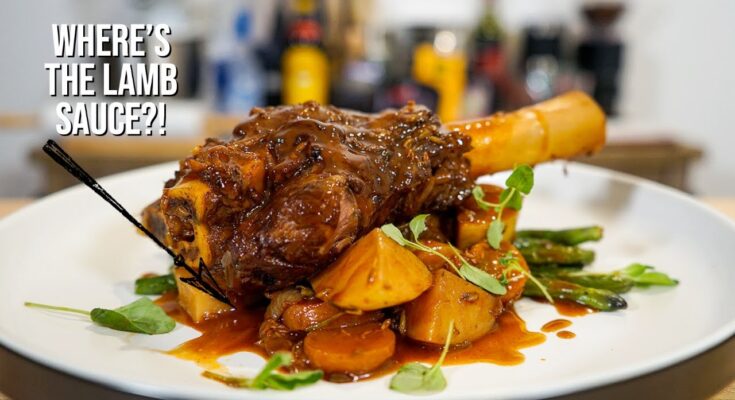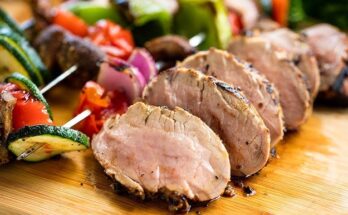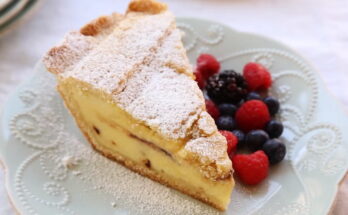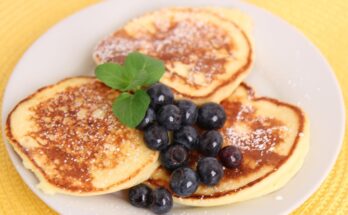Lamb Shank Recipe: There’s something incredibly satisfying about a fall-off-the-bone, slow-cooked lamb shank. This luxurious cut of meat, known for its rich flavor and tender texture, transforms into a hearty, comforting dish when cooked the right way. The beauty of lamb shank lies in its simplicity—minimal ingredients, a little patience, and you’re rewarded with a soul-warming meal that feels gourmet yet rustic.
But here’s the catch: not all lamb shank recipes are created equal. Some lack depth, others miss out on the crucial tenderness that makes this dish sing. That’s why we’ve created a foolproof, step-by-step guide that walks you through every stage of preparing a perfect lamb shank—whether you’re a seasoned home cook or just starting your culinary journey. Our method ensures every bite is juicy, aromatic, and utterly irresistible.
So if you’re craving a dish that’s both indulgent and rewarding, stay with us. You’ll learn everything from picking the right shanks to adding just the right amount of red wine and herbs for that rich, savory flavor. Ready to cook like a pro? Let’s dive into the details.
Ingredients You’ll Need
Before we get cooking, it’s essential to gather all your ingredients. The quality of your components will directly impact the final flavor, so try to go for fresh, high-grade options wherever possible.
Essential Ingredients:
- 2 large lamb shanks (bone-in)
- 2 tablespoons olive oil
- 1 large onion, finely chopped
- 3-4 garlic cloves, minced
- 2 carrots, diced
- 2 celery stalks, diced
- 1 can (14 oz) crushed tomatoes
- 2 tablespoons tomato paste
- 1 cup red wine (Cabernet Sauvignon or Merlot works well)
- 2 cups beef or vegetable stock
- 1 sprig of fresh rosemary
- 2 sprigs of thyme
- Salt and black pepper to taste
Optional Flavor Enhancers:
- 1 bay leaf
- A pinch of smoked paprika for depth
- A teaspoon of balsamic vinegar for tanginess
- Fresh parsley for garnish
These ingredients aren’t just about flavor—they build layers of complexity. The wine and herbs bring out the meat’s natural savoriness, while the tomato paste and balsamic add acidity and sweetness. The trick is balancing these notes for a robust and unforgettable dish.
Equipment and Kitchen Tools
Let’s talk gear. You don’t need a five-star kitchen to make this dish, but a few essentials can make your cooking smoother and more enjoyable.
Must-Have Kitchen Gear:
- Heavy-duty Dutch oven or oven-safe pot (cast iron preferred)
- Sharp chef’s knife for chopping
- Cutting board
- Measuring cups and spoons
- Wooden spoon or spatula for stirring
- Tongs for searing the shanks
Helpful Tips on Preparation Tools:
If you don’t have a Dutch oven, a deep baking dish tightly covered with foil can work in a pinch, although it won’t retain heat as efficiently. When searing meat, use tongs instead of a fork to avoid piercing and drying out the lamb.
Also, consider prepping your mise en place beforehand—chop all your veggies, measure your spices, and set out your ingredients. It reduces stress and makes the cooking process flow more smoothly.
Preparing the Lamb Shanks
Proper preparation is key to achieving tender, flavorful lamb shanks. Skipping or rushing this part can lead to bland results, so give it the time and attention it deserves.
Cleaning and Trimming:
First, rinse the lamb shanks under cold water and pat them dry with paper towels. Inspect the meat for any silver skin or excess fat—trimming these away will improve both texture and flavor. Don’t remove all the fat though; a little is essential for moisture and taste.
Sprinkle the shanks generously with salt and pepper on all sides. This helps to form a flavorful crust when searing.
Marinating for Maximum Flavor:
While not strictly necessary, marinating your lamb shanks can add a serious boost in flavor. If you’ve got the time, rub them with olive oil, crushed garlic, rosemary, and thyme, then let them sit in the fridge for at least 2 hours—or overnight for best results.
The herbs infuse the meat with fragrance, while the oil helps the spices cling and penetrate deeper. Think of it as laying the foundation for the rich, layered flavors to come.
Step-by-Step Cooking Instructions
Here’s where the magic happens. The slow braising method is what turns tough shanks into melt-in-your-mouth masterpieces. Follow this order, and you’ll end up with a dish worthy of a five-star review.
1. Searing the Lamb:
Start by heating olive oil in your Dutch oven over medium-high heat. Once hot, place the shanks in the pot and sear each side until golden brown—about 3-4 minutes per side. This step locks in juices and builds that deep umami base.
Remove the shanks and set them aside.
2. Building the Flavor Base:
In the same pot, add chopped onions, garlic, carrots, and celery. Cook until softened—about 7-10 minutes. Stir in tomato paste and cook for another 2 minutes to caramelize slightly, intensifying the flavor.
Next, pour in the red wine to deglaze the pot. Scrape up any browned bits from the bottom—this is flavor gold. Let the wine simmer for a few minutes until slightly reduced.
Add crushed tomatoes, stock, rosemary, thyme, and any optional enhancers like bay leaf or paprika. Stir everything together and return the lamb shanks to the pot.
3. Braising to Perfection:
Cover the pot with a lid and place it in a preheated oven at 325°F (160°C). Let the lamb shanks braise for 2.5 to 3 hours, turning them halfway through.
Check occasionally to ensure they’re not drying out—add a splash of stock or water if needed. You’ll know they’re done when the meat pulls away from the bone effortlessly.
4. Final Touch for Serving:
Remove the lamb from the pot and skim off excess fat from the sauce. Simmer the remaining liquid on the stove until slightly thickened. Taste and adjust seasoning with salt, pepper, or a dash of vinegar if desired.
Serve the shanks over creamy mashed potatoes, buttery polenta, or even a bed of couscous. Spoon the rich sauce generously on top and garnish with chopped parsley for a touch of color.
Serving Suggestions and Pairings
After all that time and love you’ve put into slow-cooking your lamb shanks, it’s only right to serve them with sides that complement their rich and savory flavors. Let’s elevate your dish with the perfect pairings that turn dinner into an experience.
Best Side Dishes for Lamb Shanks
- Creamy Mashed Potatoes: A classic choice. The smooth texture and buttery flavor balance the rich meat and soak up the sauce beautifully.
- Roasted Root Vegetables: Think carrots, parsnips, and sweet potatoes. Roasting brings out their natural sweetness, which contrasts wonderfully with the savory shank.
- Polenta or Couscous: These absorb the braising liquid well, giving each bite a luxurious, saucy boost.
- Steamed Greens: Kale, spinach, or green beans with a dash of lemon can add a needed freshness to cut through the richness.
Wine Pairing Tips
Lamb shank’s bold, earthy flavors beg for a glass of robust red wine. Here are your best bets:
- Cabernet Sauvignon: Deep, tannic, and full-bodied—it matches the strength of the lamb beautifully.
- Shiraz or Syrah: Offers a peppery, spicy edge that enhances the dish’s herbaceous notes.
- Zinfandel: Fruity yet complex, ideal for balancing the rich tomato base of the sauce.
Don’t forget to serve warm crusty bread on the side—it’s perfect for mopping up every drop of that incredible sauce.
Storage and Reheating Tips
Cooked too much? Great! Lamb shank actually tastes even better the next day, as the flavors continue to meld. Here’s how to store and reheat it without losing its deliciousness.
How to Store Leftover Lamb Shank
- Refrigerator: Allow leftovers to cool completely before transferring to an airtight container. Store for up to 3-4 days.
- Freezer: Wrap each shank individually in foil, then place in a freezer-safe bag or container. Label and store for up to 3 months.
Before freezing, consider portioning the sauce and shanks separately. This makes it easier to thaw and use just what you need later.
Reheating Without Drying Out
- Stovetop Method (Recommended): Place lamb and sauce in a covered pan over low heat. Add a splash of stock or water to keep it moist. Heat until warmed through—about 10–15 minutes.
- Oven Method: Preheat oven to 325°F. Place shanks in a covered baking dish and heat for 20–25 minutes.
- Microwave (If You Must): Not ideal, but workable. Cover loosely and heat on medium power in intervals, stirring the sauce between each one.
The goal here is to reheat slowly and evenly. Rapid heating can make the meat rubbery or dry.
Tips for Making It Even Better
Even the best recipe can be upgraded with a few chef-approved secrets. Here are expert tips to take your lamb shank game to the next level.
Use Bone-In Shanks
The bone doesn’t just add flavor—it helps retain moisture during long cooking times. Plus, there’s something primal and satisfying about pulling tender meat from the bone with your fork.
Sear for Flavor, Not Just Color
A deep, caramelized sear builds what chefs call the “Maillard reaction”—a complex flavor base that no spice can replicate. Make sure your pan is hot enough and resist the urge to move the meat too soon.
Low and Slow is the Way to Go
Tempted to raise the oven temperature to speed things up? Don’t. Low, slow cooking breaks down connective tissue, making the meat unbelievably tender.
Finish with Fresh Herbs or Citrus
Right before serving, a sprinkle of fresh parsley or a dash of lemon zest can lift the entire dish, cutting through the richness and waking up your palate.
Common Mistakes to Avoid
Even with the best intentions, a few missteps can derail your lamb shank masterpiece. Avoid these common errors to stay on the path to perfection.
Overcrowding the Pan
When searing, give your shanks room to breathe. Crowding traps steam and prevents proper browning. Work in batches if necessary.
Not Deglazing Properly
Those browned bits on the bottom of the pan? That’s where flavor lives. Don’t skip the wine (or broth) deglaze—it infuses the sauce with complex, savory depth.
Too Much Liquid
It’s a braise, not a boil. Overloading your pot with liquid can dilute flavor. You want the shanks half-submerged, not swimming.
Forgetting to Skim the Fat
Lamb is fatty by nature. After braising, always skim off excess fat from the top of your sauce. This makes the final dish richer and more refined.
FAQs about Lamb Shank Recipe
Q1: What cut of meat is a lamb shank?
A lamb shank is the lower part of the lamb leg, known for its rich, flavorful meat and connective tissue that breaks down beautifully when slow-cooked.
Q2: What’s the best cooking method for lamb shanks?
Braising is king. Slow-cooking lamb shanks in broth, wine, or tomato-based sauces gives you fall-off-the-bone tenderness and deep, savory flavor.
Q3: Can I cook lamb shanks in a slow cooker or Instant Pot?
Absolutely! Lamb shanks do great in a slow cooker or Instant Pot. Just sear them first for extra flavor, then cook low and slow (or high-pressure if you’re in a hurry).
Q4: How long should I cook lamb shanks?
It depends on your method. Oven-braising takes 2.5 to 3 hours at 160–170°C (325°F), while a slow cooker might need 6–8 hours on low. Instant Pot? About 45–60 minutes.
Q5: Do I need to marinate lamb shanks beforehand?
It’s not a must, but marinating overnight in herbs, garlic, olive oil, and a splash of wine can take the flavor to another level.
Q6: What should I serve with lamb shanks?
Creamy mashed potatoes, polenta, or buttered couscous are classic choices. Don’t forget the gravy—it’s liquid gold.
Q7: Can I freeze cooked lamb shanks?
Yes! Cool them completely, store in airtight containers with the sauce, and freeze for up to 3 months. Reheat gently to preserve that tender texture.
Q8: Why is my lamb shank tough?
If it’s still chewy, it hasn’t cooked long enough. Lamb shanks need time—don’t rush the magic of low-and-slow cooking.
Q9: Is lamb shank healthy?
Lamb shank is rich in protein, iron, and B vitamins. It’s a bit fatty, but most of the fat melts away during slow cooking. Balance it out with veggies on the side.
Q10: Can I use beef shanks instead?
Yes, beef shanks are a solid substitute, especially in braised dishes. Just expect a slightly different flavor profile and longer cook time.
Conclusion
Cooking lamb shanks doesn’t have to be intimidating. With a bit of preparation and a slow, patient approach, you can create a dish that’s hearty, deeply flavorful, and sure to impress anyone at the table. Whether it’s a quiet Sunday dinner or a special occasion, this lamb shank recipe delivers every single time.
From selecting high-quality ingredients to mastering the sear and braise, every step builds toward something greater than the sum of its parts. And once you take that first forkful of melt-in-your-mouth lamb paired with that rich, glossy sauce? You’ll understand why this dish earns its place at the top of the comfort food hierarchy.



